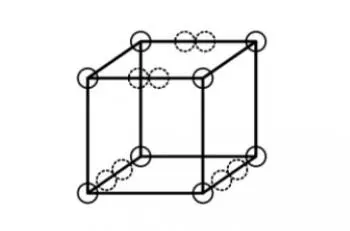
The Lewis atomic model, also known as the Lewis structure, is a method used to represent the distribution of electrons in an atom or a molecule. It was proposed by the American chemist Gilbert N. Lewis in 1916.
According to the Lewis model, atoms are made up of a central nucleus that contains protons and neutrons, and the electrons are distributed in energy levels or electron shells around the nucleus. The innermost shell, closest to the nucleus, can hold up to 2 electrons, while the outer shells can hold more.
In the Lewis representation, dots or symbols are used to represent electrons. Valence electrons, which are the electrons in the outermost shell of the atom, are represented as dots around the chemical element symbol. A maximum of two points are placed on each side (top, bottom, left, and right) before the additional points are matched.
This conception of atomic structure was a significant advance, as it provided a simplified, visual way of representing the electronic structure of atoms and the formation of chemical bonds.
Although it has been supplemented and extended by more advanced theories, it remains a valuable tool in chemistry for understanding the distribution of electrons and the interactions between atoms in molecules.
Historical context of atomic models
Before the Lewis model, there were other important atomic models, such as the Thomson model, the Rutherford model, and the Bohr model.
Each of these models provided new insights and insights into the nature of atoms, but also had limitations that could not fully explain certain observed phenomena.
Thomson's model, proposed in the late 19th century, described the atom as a positive sphere with electrons embedded in it, similar to "raisin pudding." However, this model could not explain the stability of atoms or the distribution of electrons.
Subsequently, Rutherford's model, proposed in 1911, suggested that atoms had a dense, positively charged central nucleus, while electrons orbited around this nucleus. Although this model better explained the stability of atoms, it still did not provide a complete description of how the electrons were distributed in their orbits.
It was then that Gilbert N. Lewis proposed his atomic model in 1916, known as the Lewis model. This model focused on the distribution of valence electrons, which are the electrons in the outermost shell of atoms.
Lewis proposed that the valence electrons were distributed in pairs around the atom, and that the atoms interacted with each other by sharing or transferring electrons to achieve a stable configuration.
What is the Lewis model used for?
The Lewis model is a fundamental tool in chemistry and has several important uses:
-
Representation of the electronic structure: The Lewis model allows a clear and concise visualization of the distribution of electrons in atoms, molecules and ions. It helps to understand the electronic configuration of atoms and the location of electrons in the different electronic shells.
-
Bond formation prediction: The model makes it possible to predict how atoms bond with each other to form chemical bonds. It represents the sharing or transfer of electrons between atoms to achieve a more stable electronic configuration.
-
Identification of Valence Electrons: Valence electrons are the electrons in the outermost shell of an atom and play a crucial role in chemical reactions. The conception of this model helps to identify valence electrons and understand how they interact with other atoms.
-
Representation of molecules: The Lewis model is used to represent the molecular structure of chemical compounds. It helps to visualize the arrangement of atoms and chemical bonds in a molecule.
-
Molecular Geometry Prediction: Provides information about the distribution of electrons and can be used to predict molecular geometry. This is important for understanding the physical and chemical properties of molecules, as well as their biological activity.
-
Interpretation of Chemical Reactions: This atomic model facilitates the interpretation of chemical reactions by showing how atoms and electrons are involved in chemical changes.


